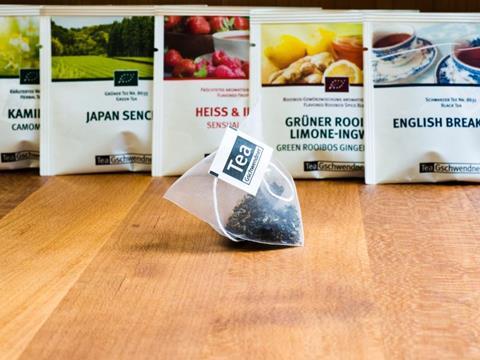
Specialist tea retailer TeeGschwendner is improving sustainability with packaging made from renewable raw materials, using Sappi Guard barrier paper for its newly developed pyramid teabags, MasterBag Pyramid.
Thanks to this paper-based solution with integrated barrier functionality, there is no need to apply additional special coatings or laminations. The innovative paper responds to market demand for alternatives to foils and plastic. In addition to lowering costs, it also reduces environmental impact. For some time, TeeGschwendner has been looking for a bright white speciality paper with a natural feel. The required product features included the ability to convey the brand image perfectly, as well as to provide the necessary strong product protection. Sappi Guard barrier paper meets all of these requirements.
The outer packaging made from Sappi Guard Gloss 4-OHG measures 8.5 x 8.5 cm and securely protects the tea bags from loss of flavour, contamination by mineral oils and damage from other environmental factors. The pack can be opened in a smooth and controlled manner and offers a pleasant consumer handling experience. The new MasterBag Pyramid tea packs will be available beginning in February 2018 in TeeGschwendner retail outlets, its online store (www.teegschwendner.de), and in selected hotels and restaurants. The tetrahedron-shaped tea bags are used to package standard and flavoured green and black teas, as well as fruit, herbal and Rooibos tea.
High level of product protection with excellent finish
“Product protection is our top priority at TeeGschwendner. The health of our consumers and protecting the precious product, which combines a number of valuable resources, are extremely important,” explains Dr. Thomas Henn, Quality Management Director at TeeGschwendner. Following a comprehensive market analysis, TeeGschwendner chose the Sappi solution because of its excellent barrier characteristics. Sappi Guard Gloss 4-OHG contains a mineral oil barrier, provides hot-melt properties and also prevents the penetration of oxygen and water vapour to protect the flavour of the tea.
Excellent printability and mechanical processing performance during test runs were further drivers to the TeeGschwendner decision. In terms of assessing paper converting and printing, TeeGschwendner put its trust in its long-term partner, Arwed Löseke. “Initially, we had some concerns as to whether the sophisticated images used by TeeGschwendner could be replicated on Sappi Guard paper with flexo”, states Marcel Steep, Director Flexo Printing at Arwed Löseke. “However, the paper’s excellent printability combined with our modern flexo printing technology meant that we were able to completely meet TeeGschwendner’s requirements.”Sustainable raw material and fewer C02 emissions
An additional reason for choosing the paper-based solution was that the packaging material was made primarily from renewable raw materials. There is a definite market trend towards sustainable paper packaging, as the consumer associates it with environmental responsibility as well as high-quality, natural content. “However, the necessary barrier properties could previously only be achieved using plastic film or aluminium composites,” adds Thomas Fernkorn, Sales Director at Arwed Löseke. “This where Sappi offers an innovative and sustainable alternative with its high-barrier paper Sappi Guard P Gloss 4-OHG. There is a great deal of interest in this solution from the market.” Sappi Guard offers an additional benefit for TeeGschwendner, as the functional paper is made from 88% FSC-certified paper. The company aims to deploy FSC-certified products wherever possible when it comes to wood and paper goods. This reflects a conscious effort to use forest resources responsibly. Sappi Guard’s low C02 emissions during manufacturing compared to alternative materials, such as aluminium composites, was an additional deciding factor for TeeGschwendner. Independent measurements conducted by Ecoinvent have shown that Sappi Guard’s paper-based barrier solution emits just half the amount of C02 during production (157 g/m2 C02) than an aluminium-coated, fossil-based composite solution.
Setting trends in tea packaging
The first MasterBags have been available in their previous format since 1999 as part of the TeeGschwendner portfolio. At the time, this type of tea bag was a novelty in the market, providing the possibility to offer high-quality loose tea in individual cups. However, the challenges this product presented, such as high production expense, slow time to market and a high proportion of manual work, led to the decision to deploy a state-of-the-art production environment and a desire to create a more attractive product line.
“Based on these production issues and our goal to redesign and relaunch all of our packaging in a sustainable manner, with product protection and environmental concerns in mind, we decided on the new MasterBag Pyramid format and a high-barrier, paper-based outer packaging, following a lengthy development and testing phase,” confirms Thomas Holz, Managing Director and Tea Taster at TeeGschwendner. “In addition to better handling and flavour protection, the new materials help increase the taste experience of each cup even further.”
More info:














